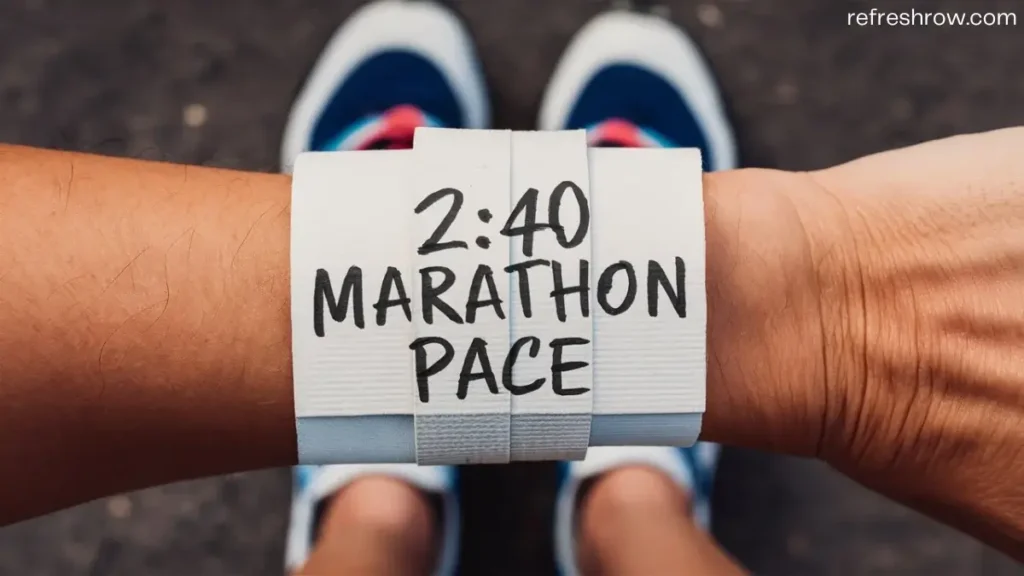To run a 2:35 hour marathon you need to run at a pace of 5:55 per mile or 3:40 per kilometer.
Following the splits below (and shaving off a second), you’ll run a sub 2:35 marathon.
I’d recommend aiming to run 1-2 minutes ahead of the split target time from 10 miles, as you’ll likely come up against crowding on race day.
2:35 Marathon Pace in Miles
| Mile | Split |
|---|---|
| 1 | 5:55 |
| 2 | 11:49 |
| 3 | 17:44 |
| 4 | 23:39 |
| 5 | 29:34 |
| 6 | 35:28 |
| 7 | 41:23 |
| 8 | 47:18 |
| 9 | 53:12 |
| 10 | 59:07 |
| 11 | 1:05:02 |
| 12 | 1:10:56 |
| 13 | 1:16:51 |
| 14 | 1:22:46 |
| 15 | 1:28:41 |
| 16 | 1:34:35 |
| 17 | 1:40:30 |
| 18 | 1:46:25 |
| 19 | 1:52:19 |
| 20 | 1:58:14 |
| 21 | 2:04:09 |
| 22 | 2:10:04 |
| 23 | 2:15:58 |
| 24 | 2:21:53 |
| 25 | 2:27:48 |
| 26 | 2:33:42 |
| 26.2 | 2:35:00 |
Download
2:35 Marathon Pace in KM
| KM | Split |
|---|---|
| 1 | 3:40 |
| 2 | 7:21 |
| 3 | 11:01 |
| 4 | 14:42 |
| 5 | 18:22 |
| 6 | 22:02 |
| 7 | 25:43 |
| 8 | 29:23 |
| 9 | 33:04 |
| 10 | 36:44 |
| 11 | 40:24 |
| 12 | 44:05 |
| 13 | 47:45 |
| 14 | 51:26 |
| 15 | 55:06 |
| 16 | 58:46 |
| 17 | 1:02:27 |
| 18 | 1:06:07 |
| 19 | 1:09:48 |
| 20 | 1:13:28 |
| 21 | 1:17:09 |
| 22 | 1:20:49 |
| 23 | 1:24:29 |
| 24 | 1:28:10 |
| 25 | 1:31:50 |
| 26 | 1:35:31 |
| 27 | 1:39:11 |
| 28 | 1:42:51 |
| 29 | 1:46:32 |
| 30 | 1:50:12 |
| 31 | 1:53:53 |
| 32 | 1:57:33 |
| 33 | 2:01:13 |
| 34 | 2:04:54 |
| 35 | 2:08:34 |
| 36 | 2:12:15 |
| 37 | 2:15:55 |
| 38 | 2:19:35 |
| 39 | 2:23:16 |
| 40 | 2:26:56 |
| 41 | 2:30:37 |
| 42 | 2:34:17 |
| 42.2 | 2:35:00 |
Download
Other Marathon Pace Charts
Targeting a different time?
Check out the Full Marathon Pace Chart in Miles or KM
Or select a specific finishing time below:
| 3:00 | 4:00 | 5:00 | |
| 3:05 | 4:05 | 5:15 | |
| 3:10 | 4:10 | 5:30 | |
| 3:15 | 4:15 | 5:45 | |
| 3:20 | 4:20 | 6:00 | |
| 3:25 | 4:25 | 6:15 | |
| 2:30 | 3:30 | 4:30 | 6:30 |
| 2:35 | 3:35 | 4:35 | 6:45 |
| 2:40 | 3:40 | 4:40 | 7:00 |
| 2:45 | 3:45 | 4:45 | |
| 2:50 | 3:50 | 4:50 | |
| 2:55 | 3:55 | 4:55 |
Training for a 2:35 Marathon
Is 2:35 a Good Marathon Time?
Well, what do the stats say?
Run Repeat conducted a study that contains 19,614,975 marathon results from more than 32,335 races across the globe, here is how a 2:35 marathon compares against age and gender for the races recorded:
| Overall | You’re faster than 99.7% of all runners. |
| Male | You’re faster than 99.5% of males. |
| Female | You’re faster than 99.9% of females. |
| <20 | You’re faster than 99.0% of under 20s. |
| 20-29 | You’re faster than 99.2% of 20-29 year olds. |
| 30-39 | You’re faster than 99.6% of 30-39 year olds. |
| 40-49 | You’re faster than 99.9% of 40-49 year olds. |
| 50-59 | You’re faster than 100% of 50-59 year olds. |
| >60 | You’re faster than 100% of over 60s. |
Training Runs and Paces for a 2:35 Marathon
To break a 2:35 marathon you’ll need to do some serious distance in your training, I recommend at least 35 miles (56km) per week.
You’re also going to need to make sure you’ve crossed off these milestones for other race distances:
- A 5k in 16:15 mins
- A 10k in 31:20 mins
- A half marathon in 1 hour 11 mins
Pace for Training
| Pace | Mins per Mile | Mins per KM |
|---|---|---|
| Easy | 6:26 | 4:00 |
| Steady | 5:43 | 3:33 |
| 10k | 5:14 | 3:15 |
| 5k | 5:02 | 3:02 |
| 1 Mile | 4:40 | 2:55 |
Weekly Mileage Targets
| Target Mileage: | Gradually increase your weekly mileage from 40 miles (64 km) to a peak of 68 miles (109 km). |
| Incremental Increase: | Increase mileage by approximately 10% each week, with every fourth week as a recovery week where mileage is reduced by 20-30%. Make sure to taper for the last 1-2 weeks. |
Long Run Structure
| Total Distance: | Build up to long runs of 20-22 miles (32-35 km). |
| Segment Example: | First 5 miles (8 km): Easy pace, heart rate 140-150 bpm (approximately 6:45/mile or 4:12/km). Next 1 mile (1.6 km): Fast pace at 5:00/mile (3:06/km). Next 5 miles (8 km): Medium effort, heart rate around 160 bpm (approximately 6:00/mile or 3:44/km). Repeat: Repeat the segment twice (5 miles easy, 1 mile fast, 5 miles medium), you can taper the final 2 miles if required. |
Why This Works: Incorporating varied paces within long runs enhances lactate tolerance, which helps on race day when you’ve got to maintain pace despite feeling fatigued. By practicing surges during a run, you can build up your physical and mental resilience (lots of elite marathon runners use these strategies during their training)
Alternating Long Runs: Alternate between structured long runs (easy/fast segments) and easier long runs. For easier long runs, maintain a steady, comfortable pace throughout, focusing on mileage rather than speed to aid recovery.
Speedwork Sessions
| Short Intervals: | – 800m repeats at 2:37 per interval (3:15/km). – Aim for 6-12 repetitions with equal time for recovery. |
| Mile Repeats: | – 1 mile repeats at 5:15 per mile (3:15/km). – Aim for 6-12 repetitions with a 1-2 minute recovery jog. |
| Longer Intervals: | – 2 mile repeats at 5:25 per mile (3:22/km). – Aim for 5-8 repetitions with a 2-3 minute recovery jog. |
Recovery and Rest Days
| Rest Days: | You don’t need to incorporate rest days if you are using recovery runs, but I recommend taking 1 (or a max of 2) per week to allow your body to recover and prevent overtraining. |
| Easy Run Days: | Include 1-2 easy run days per week at a relaxed pace of 8:30/mile (5:17/km), covering 5-10 miles (8-16 km) per day. Try to keep your heart rate below 140 bpm on easy days to ensure proper recovery and aerobic development. |
My Tips to Run a Sub 2:35 Marathon


Row Brown is the founder of Refresh Row. He is a keen marathon runner, his favorite being the London Marathon. He’s now set himself the mission of Running the Entire Length of Spain, which is scheduled for late 2024.


